
Allium ursinum, known as wild garlic, ramsons,wild cowleek, cowlic, buckrams, broad-leaved garlic, wood garlic, bear leek or bear's garlic, is a bulbous perennial flowering plant in the amaryllis family Amaryllidaceae. It is native to Europe and Asia, where it grows in moist woodland. It is a wild relative of onion and garlic, all belonging to the same genus, Allium. There are two recognized subspecies: A. ursinum subsp. ursinum and A. ursinum subsp. ucranicum.

Agapanthus praecox is a popular garden plant around the world, especially in Mediterranean climates. It is native to the Kwa-Zulu Natal and Western Cape provinces of South Africa. Local names include agapant, bloulelie, isicakathi and ubani. Most of the cultivated plants of the genus Agapanthus are hybrids or cultivars of this species. It is divided into three subspecies: subsp.praecox, subsp. orientalis and subsp. minimus.

Hakea epiglottis is a shrub commonly known as beaked hakea or needlebush hakea and is endemic to Tasmania where populations consist of functional unisexual plants. In a 1989 publication by John Wrigley & Murray Fagg states specimens at Wakehurst Place, an annexe of Kew Gardens London are specimens believed to be 60-70 years old measuring 3 m (9.8 ft) high and wide.

Hakea pandanicarpa is a shrub species in the family Proteaceae. It is endemic to south-west Western Australia.
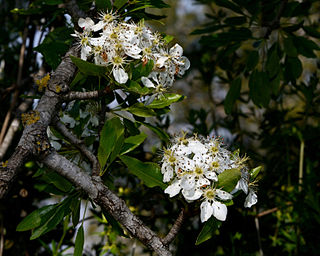
Pyrus syriaca is a deciduous tree in the Rosaceae family. It is referred to by the common name Syrian pear. It is the only pear species which grows in the wild in Lebanon, Turkey, Syria and Israel.
Iris cedreti is a species of flowering plant in the genus Iris; it is also in the subgenus of Iris. It is a rhizomatous perennial endemic to Lebanon. It has long narrow leaves, short stem, and flowers with a white background which is covered with very small dots or veins of dark maroon, purple, purplish-maroon, or almost black. It has a dark maroon signal patch with a brownish or purplish beard. It is rarely cultivated as an ornamental plant in temperate regions, as it needs very dry conditions during the summer. It is listed as critically endangered by the IUCN.

Berberis libanotica is a species of plant in the family Berberidaceae.

Dianthus strictus, known as the wild pink, is a species of flowering plant in the family Caryophyllaceae.
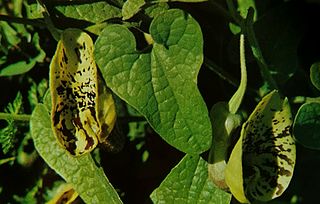
Aristolochia delavayi, known as the party-colored birthwort, is a species of flowering plant in the family Aristolochiaceae.
Matthiola crassifolia, the thick-leaved stock, is a species of plant in the family Brassicaceae.

Sedum hispanicum, the Spanish stonecrop, is a species of plant in the family Crassulaceae.

Ononis natrix, the yellow restharrow or shrubby rest-harrow, is a species of plant in the family Fabaceae.

Eminium spiculatum is a species of plant in the family Araceae.
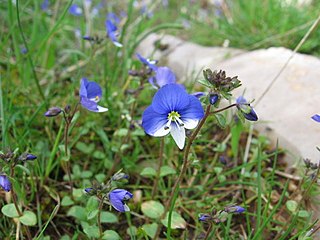
Veronica syriaca, the Syrian speedwell, is a flowering plant species in the family Plantaginaceae. The generic name of this flower is of unknown origin. Some think it is a distortion of betonica, the Latin name of a species of Labiates; others consider that it refers to Saint Veronica who handed a cloth to Christ to wipe the perspiration from his face.
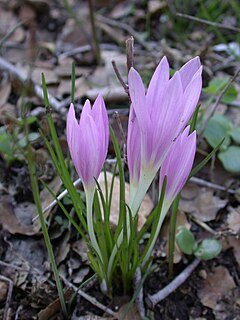
Colchicum stevenii, or Steven's meadow saffron, is a species of flowering plant in the family Colchicaceae. Arabic: سَراجُ الغولة, سُورَنْجان Hebrew: סתוונית היורה
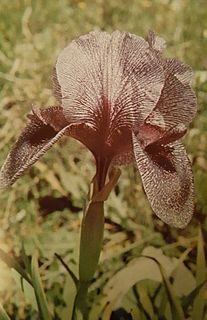
Iris susiana is a species of plant in the family Iridaceae native to Lebanon. This beautiful and big iris, with a span easily reaching twelve centimeters. It grows nowadays in Lebanon, Syria and Turkey where its survival is seriously threatened by excessive picking.

Erodium acaule is a species of plant in the family Geraniaceae.
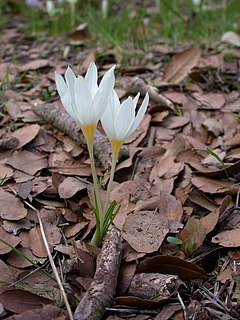
Crocus ochroleucus is species of flowering plant in the Iridaceae family. It is a cream-colored crocus native to Lebanon, Palestine and Syria.
Iris westii is a species in the genus Iris, it is also in the subgenus of Iris and in the Oncocyclus section. It is from the mountain sides of Lebanon. It has curved grey-green leaves, a stem carrying one flower in shades of lilac, white or beige with spotting or veins in a darker shade or violet. The lower petals have deep velvety chocolate or deep violet-black signal patch and a purple beard. It rare and threatened due to habitat destruction, from military actions, overgrazing by goats and other factors.
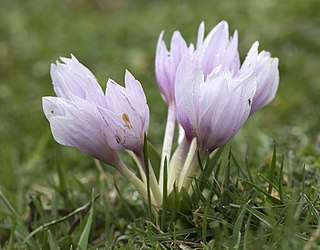
Colchicum szovitsii is a species of flowering plant in the family Colchicaceae, native from eastern Bulgaria to northwestern Jordan and Iran. It was first described in 1835.

















